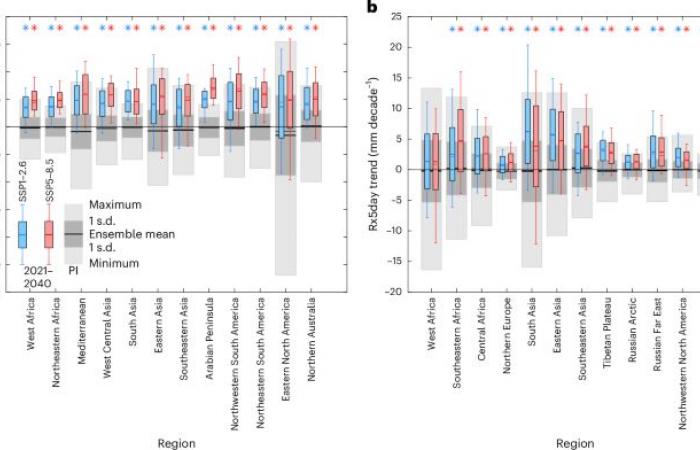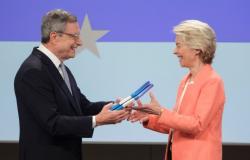
IPCC: Summary for Policymakers. In Climate Change 2021: The Physical Science Basis (eds Masson-Delmotte, V. et al.) (Cambridge Univ. Press, 2021); https://doi.org/10.1017/9781009157896.001
Gulev, SK et al. in Climate Change 2021: The Physical Science Basis (eds Masson-Delmotte, V. et al.) 287–422 (Cambridge Univ. Press, 2021); https://doi.org/10.1017/9781009157896.004
Samset, B. H. et al. Steady global surface warming from 1973 to 2022 but increased warming rate after 1990. Commun. Earth Environ. 4400 (2023).
Article
Google Scholar
Smith, S. J., Edmonds, J., Hartin, C. A., Mundra, A. & Calvin, K. Near-term acceleration in the rate of temperature change. Nat. Clim. Change 5333–336 (2015).
Article
Google Scholar
Loarie, S. R. et al. The velocity of climate change. Nature 4621052–1055 (2009).
Article
CAS
Google Scholar
O’Neill, B. C. & Oppenheimer, M. Climate change impacts are sensitive to the concentration stabilization path. Proc. Natl Acad. Sci. USA 10116411–16416 (2004).
Article
Google Scholar
Fischer, E. M., Sippel, S. & Knutti, R. Increasing probability of record-shattering climate extremes. Nat. Clim. Change 11689–695 (2021).
Article
Google Scholar
Philip, S. Y. et al. Rapid attribution analysis of the extraordinary heat wave on the Pacific coast of the US and Canada in June 2021. Earth Syst. Dyn. 131689–1713 (2022).
Article
Google Scholar
Ranasinghe, R. et al. in Climate Change 2021: The Physical Science Basis (eds Masson-Delmotte, V. et al.) 1767–1926 (Cambridge Univ. Press, 2021); https://doi.org/10.1017/9781009157896.014
Zscheischler, J. et al. Future climate risk from compound events. Nat. Clim. Change 8469–477 (2018).
Article
Google Scholar
Seneviratne, S. I. et al. in Climate Change 2021: The Physical Science Basis (eds Masson-Delmotte, V. et al.) 1513–1766 (Cambridge Univ. Press, 2021); https://doi.org/10.1017/9781009157896.013
IPCC Climate Change 2021: The Physical Science Basis (eds Masson-Delmotte, V. et al.) (Cambridge Univ. Press, 2021); https://doi.org/10.1017/9781009157896
Sedláček, J. & Knutti, R. Half of the world’s population experience robust changes in the water cycle for a 2 °C warmer world. Environ. Res. Lett. 9044008 (2014).
Article
Google Scholar
Lehner, F. & Stocker, T. F. From local perception to global perspective. Nat. Clim. Change 5731–734 (2015).
Article
Google Scholar
Chavaillaz, Y., Joussaume, S., Dehecq, A., Braconnot, P. & Vautard, R. Investigating the pace of temperature change and its implications over the twenty-first century. Climatic Change 137187–200 (2016).
Article
Google Scholar
Iturbide, M. et al. An update of IPCC climate reference regions for subcontinental analysis of climate model data: definition and aggregated datasets. Earth Syst. Sci. Data 122959–2970 (2020).
Article
Google Scholar
Sanderson, B. M., Oleson, K. W., Strand, W. G., Lehner, F. & O’Neill, B. C. A new ensemble of GCM simulations to assess avoided impacts in a climate mitigation scenario. Climatic Change 146303–318 (2018).
Article
Google Scholar
Hawkins, E. & Sutton, R. Time of emergence of climate signals. Geophys. Res. Lett. 39L01702 (2012).
Article
Google Scholar
King, A. D. et al. The timing of anthropogenic emergence in simulated climate extremes. Environ. Res. Lett. 10094015 (2015).
Article
Google Scholar
Diffenbaugh, N. S. & Scherer, M. Observational and model evidence of global emergence of permanent, unprecedented heat in the 20th and 21st centuries. Climatic Change 107615–624 (2011).
Article
Google Scholar
Chen, D. et al. in Climate Change 2021: The Physical Science Basis (eds Masson-Delmotte, V. et al.) 147–286 (Cambridge Univ. Press, 2021); https://doi.org/10.1017/9781009157896.003
Mahlstein, I., Knutti, R., Solomon, S. & Portmann, R. W. Early onset of significant local warming in low latitude countries. Environ. Res. Lett. 6034009 (2011).
Article
Google Scholar
Nguyen, T.-H., Min, S.-K., Paik, S. & Lee, D. Time of emergence in regional precipitation changes: an updated assessment using the CMIP5 multi-model ensemble. Clim. Dyn. 513179–3193 (2018).
Article
Google Scholar
Mahlstein, I., Portmann, R. W., Daniel, J. S., Solomon, S. & Knutti, R. Perceptible changes in regional precipitation in a future climate. Geophys. Res. Lett. 39L05701 (2012).
Article
Google Scholar
United Nations Framework Convention on Climate Change Paris Agreement (United Nations, 2015); https://unfccc.int/sites/default/files/resource/parisagreement_publication.pdf
Wilcox, L. J. et al. Accelerated increases in global and Asian summer monsoon precipitation from future aerosol reductions. Atmos. Chem. Phys. 2011955–11977 (2020).
Article
CAS
Google Scholar
Hawkins, E. & Sutton, R. The potential to narrow uncertainty in projections of regional precipitation change. Clim. Dyn. 37407–418 (2011).
Article
Google Scholar
Lehner, F. et al. Partitioning climate projection uncertainty with multiple large ensembles and CMIP5/6. Earth Syst. Dyn. 11491–508 (2020).
Article
Google Scholar
Persad, G. et al. Rapidly evolving aerosol emissions are a dangerous omission from near-term climate risk assessments. Environ. Res. Clim. 2032001 (2023).
Article
Google Scholar
Schumacher, D. L. et al. Exacerbated summer European warming not captured by climate models neglecting long-term aerosol changes. Commun. Earth Environ. 5182 (2024).
Article
Google Scholar
Gridded Population of the World, Version 4 (GPWv4): Population Density Adjusted to Match 2015 Revision UN WPP Country Totals, Revision 11 (CIESIN, 2018); https://doi.org/10.7927/H4F47M65
Eyring, V. et al. Overview of the Coupled Model Intercomparison Project Phase 6 (CMIP6) experimental design and organization. Geosci. Model Dev. 91937–1958 (2016).
Article
Google Scholar
Mackallah, C. et al. ACCESS datasets for CMIP6: methodology and idealised experiments. J. South. Hemisph. Earth Syst. Sci. 7293–116 (2022).
Article
Google Scholar
Mauritsen, T. et al. Developments in the MPI-M Earth System Model version 1.2 (MPI-ESM1.2) and its response to increasing CO2. J. Adv. Model. Earth Syst. 11998–1038 (2019).
Article
Google Scholar
Swart, NC et al. CCCma CanESM5 Model Output Prepared for CMIP6 CMIP Historical (Earth System Grid Federation, 2019); https://doi.org/10.22033/ESGF/CMIP6.3610
Döscher, R. et al. The EC-Earth3 Earth system model for the Coupled Model Intercomparison Project 6. Geosci. Model Dev. 152973–3020 (2022).
Article
Google Scholar
Wyser, K. et al. The SMHI Large Ensemble (SMHI-LENS) with EC-Earth3.3.1. Geosci. Model Dev. 144781–4796 (2021).
Article
Google Scholar
Meehl, G. A. et al. Context for interpreting equilibrium climate sensitivity and transient climate response from the CMIP6 Earth system models. Sci. Adv. 6eaba1981 (2022).
Article
Google Scholar
O’Neill, B. C. et al. The Scenario Model Intercomparison Project (ScenarioMIP) for CMIP6. Geosci. Model Dev. 93461–3482 (2016).
Article
Google Scholar
Sillmann, J., Kharin, V. V., Zhang, X., Zwiers, F. W. & Bronaugh, D. Climate extremes indices in the CMIP5 multimodel ensemble: part 1. Model evaluation in the present climate. J. Geophys. Res. Atmos. 1181716–1733 (2013).
Article
Google Scholar
Hersbach, H. et al. The ERA5 global reanalysis. Q. J. R. Meteorol. Soc. 1461999–2049 (2020).
Article
Google Scholar
Contractor, S. et al. Rainfall Estimates on a Gridded Network (REGEN)—a global land-based gridded dataset of daily precipitation from 1950 to 2016. Hydrol. Earth Syst. Sci. 24919–943 (2020).
Article
Google Scholar
Ziese, M. et al. GPCC Full Data Daily Version.2018 at 1.0°: Daily Land-Surface Precipitation from Rain-Gauges built on GTS-based and Historic Data (GPCC, 2018); https://doi.org/10.5676/DWD_GPCC/FD_D_V2018_100
Menne, M. J., Durre, I., Vose, R. S., Gleason, B. E. & Houston, T. G. An overview of the global historical climatology network-daily database. J. Atmos. Ocean. Technol. 29897–910 (2012).
Article
Google Scholar
Gridded Population of the World, Version 4 (GPWv4): Population Count Adjusted to Match 2015 Revision of UN WPP Country Totals, Revision 11 (CIESIN, 2018); https://doi.org/10.7927/H4PN93PB
Sandstad, M., Schwingshackl, C. & Iles, C. Climate Extreme Indices and Heat Stress Indicators Derived from CMIP6 Global Climate Projections (C3S CDS, 2022); 1https://doi.org/10.24381/cds.776e08bd
Iles, C. E. Data and code archival for Iles et al. 2024, Nature Geoscience, ‘Strong regional trends in extreme weather over next two decades under high and low emission pathways’. Zenodo https://doi.org/10.5281/zenodo.12704988 (2024).
Hersbach, H. et al. ERA5 Hourly Data on Single Levels from 1940 to Present (C3S CDS, 2023); https://doi.org/10.24381/cds.adbb2d47
Contractor, S. Rainfall Estimates on a Gridded Network (REGEN) Based on Long-Term Station Data v.1–2019 (NCI Australia, 2019); https://doi.org/10.25914/5ca4c2c6527d2
Contractor, S. Rainfall Estimates on a Gridded Network (REGEN) Based on All Station Data v.1–2019 (NCI Australia, 2019); https://doi.org/10.25914/5ca4c380b0d44
Kim, Y.-H., Min, S.-K., Zhang, X., Sillmann, J. & Sandstad, M. Evaluation of the CMIP6 multi-model ensemble for climate extreme indices. Weather Clim. Extrem. 29100269 (2020).
Article
Google Scholar





